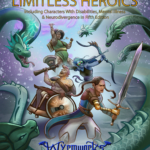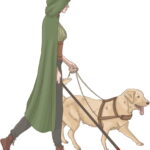Partial Field Blindness/Agnosia

You’re unable to see or recognize certain areas or features. Choose or roll on the following table.
| d20 | Visual Difference |
|---|---|
| 1–8 | Closed Angle Vision |
| 9–14 | Open Angle Vision |
| 15–16 | Humanoid Agnosia |
| 17–18 | Animal Agnosia |
| 19–20 | Topographical Agnosia |
- Closed Angle Vision. You have “tunnel vision,” enabling you to see in a 60 ÷ (IE) degree cone. All Wisdom (Perception) checks involving sight outside of that field are made with disadvantage.
- Open Angle Vision. You only have peripheral vision and have a blind spot in the center of your field of vision. This makes it almost impossible to read or focus on details since peripheral vision doesn’t have the same level of detail. This gives you a −(IE) penalty on all ranged attack rolls, Wisdom (Insight) checks, and Wisdom (Perception) checks that depend on detailed vision, and you need to succeed on a DC 12 + (IE) Wisdom (Perception) check to read standard writing. This also gives you a −(IE) penalty on all ranged attack rolls and other ranged actions that require depth perception such as jumping. Due to your dependence on your peripheral vision, you have a +1 bonus to Wisdom (Perception) checks against Dexterity (Stealth). Because you can’t see details, you rely on your other senses and have a +(IE) bonus on Dexterity (Sleight of Hand) checks that rely on touch, like picking locks.
- Humanoid Agnosia. You are unable to recognize a specific part of a humanoid body or distinguish it from others. Choose or roll on the following table.
Somewhere in this grocery section is my lover, and I can’t tell which human she is.
-MaimakteriAnn
| d20 | Feature |
|---|---|
| 1–8 | Face |
| 9–10 | Fingers/hands/claws |
| 11–13 | Hair |
| 14–16 | Clothing |
| 17–20 | Voice |
The IE determines how much you can discern:
IE 1: You can see them but don’t recognize them, even your own.
IE 2: You can’t recognize any detail. One is like another.
IE 3: It appears as a jumbled mess and isn’t discernible as such.
IE 4: It’s as if it’s not even there for you unless it makes noise or you can touch or smell it.
This is true of the actual feature or artistic depictions or representations of it.
As a result, you have disadvantage and a penalty of −(IE) to distinguish even the most basic of details regarding recognizing or remembering that feature. You’ve learned to focus on the other features to recognize individuals, which gives you a +(IE) to Intelligence checks to remember or know about a specific subject such as hairstyles or jewelry.
- Animal Agnosia. You can’t recognize beasts and monstrosities that don’t have a humanoid shape. The IE determines what you see:
IE 1: You can see them but don’t recognize them, even your own pet.
IE 2: You can’t recognize any detail. One is like another except for size and sound.
IE 3: It appears as a jumbled mess and isn’t discernible as an animal.
IE 4: It’s as if it’s not even there for you unless it makes noise or you can touch or smell it.
This is true of the actual animal or artistic depictions or representations of it.
As a result, you have a penalty of −(IE) to distinguish even the most basic of details regarding recognizing or remembering that animal and a −(IE) penalty on all attack or Wisdom (Animal Handling) checks against it. At the same time, you have a +(IE) bonus against gaze attacks and other sight-based attacks from such creatures.
- Topographical Agnosia. You can’t discern places and get lost easily and have a −(IE) penalty on Wisdom (Survival) checks. This experience manifests according to the IE as follows:
IE 1: You know what kind of environment you’re in, but it’s not familiar, as if it’s your first time there, even your own home.
IE 2: You can’t tell what kind of building or environment you’re in besides recognizing colors and using your other senses.
IE 3: You can’t tell whether an environment is hostile or know how to prepare for that environment.
IE 4: You can’t tell whether you’re in an urban or wilderness environment. You can interact with the environment, but you can’t piece together clues (e.g., sand in the desert, clattering dishes in an inn) to know what kind of environment you’re in, even between urban and wilderness.
Consequently, you have a −(IE) penalty on all Wisdom (Survival) and Intelligence (Nature) checks.
Real-world Examples
Prosopagnosia, Finger Agnosia, Topographical Disorientation, Glaucoma, Retinitis Pigmentosa
Assistive Options
Specialized fish-eye lens spectacles can correct for one IE of Closed Angle Vision. (A specialized artisan would need to be found in a large city and charge 200 gp + (IE) × 200 gp for the spectacles.) Those with agnosia can sometimes use other characteristics to recognize a person or animal. Those with Topographical Agnosia can ask others where they are.
Magical Assistance
The Find Familiar spell allows you to use your familar’s senses for a turn. Consult the spell description for more details. Spells that allow for alternate senses such as Clairvoyance spell can also temporarily help those with these disabilities.
